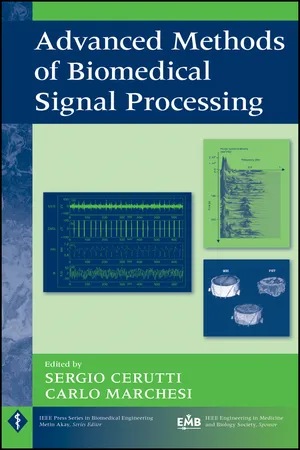![]()
PART I
FUNDAMENTALS OF BIOMEDICAL SIGNAL PROCESSING AND INTRODUCTION TO ADVANCED METHODS
![]()
CHAPTER 1
METHODS OF BIOMEDICAL SIGNAL PROCESSING
Multiparametric and Multidisciplinary Integration toward a Better Comprehension of Pathophysiological Mechanisms
Sergio Cerutti
1.1 INTRODUCTION
It is well known that medicine, in both research environments (particularly in physiology) and clinical applications, is becoming a more and more quantitative discipline based upon objective data obtained from the patient or the subject under examination through digital parameters, vital signs and signals, images, statistical and epidemiological indicators, and so on. Today, even clinical applications cannot be made without a more or less extended background of quantitative indicators that complement generally anamnestic parameters as well as those of the typical objective examination. Patients’ medical records therefore contain more and more data, signals, images, indicators of normality, morbidity, sensitivity, and specificity, and other numerical parameters that must be properly integrated in order to help physicians to make correct decisions for diagnostic evaluations as well as in therapeutic interventions.
Actually, proper sensors or transducers are able to make biological measurements at the various parts of the human body, from the usual electrocardiographic (ECG) or electroencephalographic (EEG) signals, arterial blood pressure signals (ABP), respiration, and so on, up to metabolic signals obtainable from a proper processing of functional images from functional magnetic resonance imaging (fMRI), positron emission tomography (PET), and other means. Hence, the information detectable from the patient has grown by considering various organs and systems simultaneously.
Even in biology, mainly due to the very strong acceleration of research in the last few years into the genome and proteome structure sequencing, much importance has been attributed to the methods that allow the information treatment starting from sequences formed by four bases (A, C, G, T) in the genome and twenty amino acids, which are the constituents of the proteins in the proteome. Many of the methods of information treatment, in the form of biomedical signals and data, can be applied to these sequences, after a proper transformation into numerical series; and this is certainly only a single example of the possible important innovative applications of biomedical engineering to molecular biology.
This chapter and the next one illustrate the fundamentals of a modern approach to the processing and interpretation of biomedical signals by exploring the main research lines and some of the many applications that will be examined in more detail in subsequent chapters. Knowledge of these methods, their algorithms, and the techniques used for their realizations can become a sophisticated investigational tool, not only to enhance useful information from the signals (which is the more “traditional” objective of this discipline) but even to approach in a more quantitative way the study of complex biological systems, certainly with a more important impact on the improvement of the physiological knowledge as well as the clinical applications. It is fundamental to remember that the more advanced methods in the area of biomedical signal processing do integrate the more advanced processing algorithms with the necessary knowledge of the systems under study. Hence, to obtain innovative results in this research, it is necessary to achieve multidisciplinary and interdisciplinary knowledge; certainly, the biomedical engineer can be one of the main actors toward these ends.
In Section 1.2, the fundamentals on which the main methods of traditional signal analysis are based will be examined and the most important definitions provided. It is not pretended that this theme can be adequately covered in a short section; rather, it is intended to define the starting bases and provide some topical references to provide a better understanding of the following contributions in the book, even for readers who have not had the opportunity to tackle the fundamentals of signal processing. Then, a section will be dedicated to the important connection between signal processing and modeling of biological systems (which is also referred to as “model-based biomedical signal processing”), which allows one to obtain information through an approach that employs knowledge of the pathophysiological phenomenon under examination. Finally, some methods of information integration will be introduced, which come from different signals, images, systems, modalities, and observation means, constituting the basis for the comprehension of more advanced methods of information-content treatment of biological phenomena, which is the main objective of the present volume.
1.2 FUNDAMENTAL CHARACTERISTICS OF BIOMEDICAL SIGNALS AND TRADITIONAL PROCESSING APPROACHES
A biomedical signal is a phenomenon that carries information relative to one or more biological systems involved. Obviously, we may find biomedical signals at different observation scales: as an example, at the level of a functional organ (heart, brain, liver, kidneys, etc.), at a system level (cardiovascular, central nervous, endocrine–metabolic systems, etc.), but also at the level of the cell or even at a subcellular level, as indicated in the previous section, as well as in higher dimension systems, as in the case of the quantitative study of morbidity, mortality, and the mechanisms of propagation of an epidemic disease inside a certain population.
The usual objective is generally to enhance the information that “travels” on these signals or data sequences in the best suitable way, according to prefixed aims. In fact, there does not exist a unique way to process signals, but rather a plurality of approaches, even very different ones, which the expert in biomedical signal processing will choose on the bases of the objectives (which information am I interested in?), the experimental protocols, the available a priori information, and the cost/performance ratio to be optimized.
The fundamental biologi...
